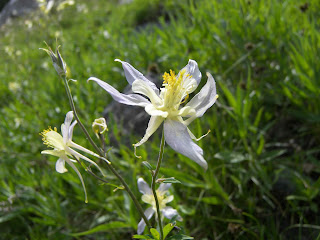
I climbed The Grand. Finally. After a month of looking at it from numerous angles in varying weather at differing times of the day, I was
 able to look at it from above, staring down at its bulk and complexity. The 360° view in perfectly clear weather was unobstructed by other mountains, for the Grand Teton is the highest in the range (of course!) and the second highest mountain in Wyoming, just 29 feet shy of Gannett Peak's 13,799 feet.
able to look at it from above, staring down at its bulk and complexity. The 360° view in perfectly clear weather was unobstructed by other mountains, for the Grand Teton is the highest in the range (of course!) and the second highest mountain in Wyoming, just 29 feet shy of Gannett Peak's 13,799 feet.
The Grand was first (undisputedly) climbed in 1898, though attempts on it had been made or reported for over 50 years prior to that. With over a century of climbing activity, this is a mountain whose scenery is matched by its history. Famous names abound on the features, such as the Exum ridge, the Petzoldt Ridge, and the Beckey Couloir. Routes and pitches such as the Owen-Spalding, the Underhill Route and Unsoeld's Lieback celebrate the achievements of the namesakes, while the Teepe Pillar and the Rosenberg Slot are eponymous remembrance of those who there met untimely deaths. There are the stories of The Impossible Rescue in 1967 and Glen Exum's likely unrepeated 1932 jump across a death chasm which enabled him to establish, solo at the age of 21, the classic line of the mountain.

View of The Grand from The Saddle
My climb followed a typical ascent schedule—an unhurried hike on the first day to the Lower Saddle, a ridge that separates the Grand Teton from the Middle Teton, followed by the climb and descent on the second day. I was fortunate enough to have access to the Exum Guide hut and equipment located at the Lower Saddle, meaning that my partner Susan and I hiked in unencumbered with either camping or climbing gear.
The night was spent in one of the caves located just below the crest of the Saddle. The sunset as viewed from inside the cave, snugly ensconced in a sleeping bag, was soothing as the golden light gently played upon the features of our den for the night. Though Susan had never climbed the first portion of our route, the Lower Exum, she had spent considerable time on the second portion, the Upper Exum, and on the descent. We were not worried about route finding and, with a perfect forecast for the morrow, had no need of an alpine start (i.e. a three or four a.m. awakening).

Sunset view from inside our cave, above, and sleeping soundly, right
Sleeping soundly till 6, we were hiking by 7 and at the base of the climb by 8. Susan had been able to scope out the beginning of the route from the hut when we arrived, so she took the first lead. The first few pitches were still in shadow and the rock was cold but not unpleasant. But what a glorious feeling it was when we finally popped around an outcropping into sunlight! We instantly started shedding layers, and soon warmed up to the rock and to the rhythm of climbing.
Still in the shadows, but smiling
Susan in the sun and having fun!
After the Lower Exum, the climbing eases off and we changed into our more comfortable approach shoes and simul-climbed much of the Upper Exum, belaying here and there when needed. We were finally into our light and (relatively) fast mode, and we took turns leading up through the Golden Stair, the Wind Tunnel, the Double Cracks, the Friction Pitch, Unsoeld's Lieback, and The Boulder Problem In The Sky. The top came rather suddenly—I led up through some rocky terrain and...there we were, on top, a mile and a third above and a world away from our starting point the previous day. Susan and I lunched and lounged in the sun, celebrating my first trip to the top of the Grand, and our first climb together.
Yay!
Jackson Hole, far below
We hung about the Exum hut for a while on the descent, returning borrowed gear and grabbing a quick bite before returning down the mountain. About halfway down from the Saddle, there is a flat area in the valley, a mini Shangri-La of streams, grasses, and alpine flowers, and ther we spotted an American Dipper, the only aquatic songbird in North America. We watched for several minutes as the Dipper bobbed up and down on a rock, and then ducked underneath the rushing waters to grab some grub. Several hours later I mimicked the Dipper, ducking underneath some rushing water from the cabin shower and grabbing my own grub, then retiring to sweet dreams of mountains and streams and sunlit skies.
















